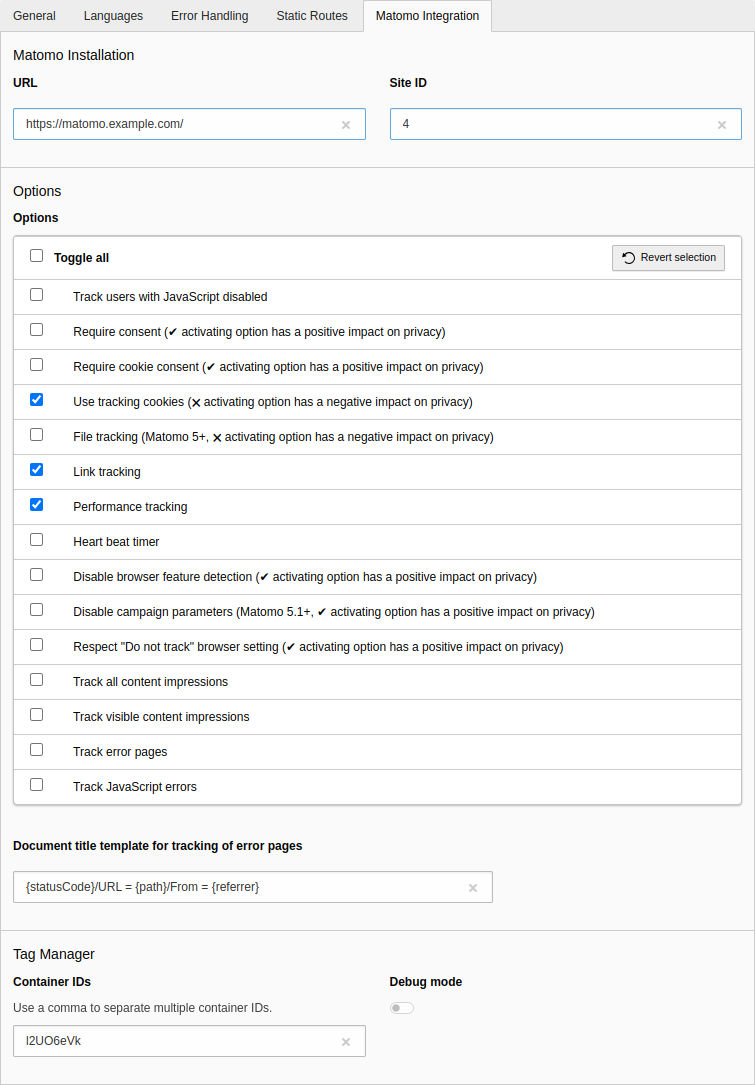Configuration
Target group: Developers, Integrators
Site configuration
To configure the extension, go to Site Management > Sites and select the appropriate site configuration. Click on the Matomo Integration tab:

Options in the site configuration
Attention
After you have adjusted the settings in the site configuration, you must flush the cache.
Note
The Matomo integration is only active, if a URL and a site ID are specified.
Installation
- URL
- Enter the URL of your Matomo instance (without
matomo.at the end). Relative URLs can be used, likephp //.matomo. example. com/ - Site ID
- Enter the site ID for the website.
Options
Note
The initial status of the options corresponds to the default JavaScript tracking code specified via the menu Administration > Measurables in Matomo.
- Track users with JavaScript disabled
-
If this option is enabled, users with JavaScript disabled will be tracked. Technically, a
<noscript>tag is embedded in the web page.Default: disabled
- Require consent
-
Activating this option has a positive impact on privacy.
Enable this option when a consent manager is used which sets up consent tracking: no tracking request will be sent to Matomo and no cookies will be set. For more information have a look into Implementing tracking or cookie consent with the Matomo JavaScript Tracking Client.
Default: disabled
- Require cookie consent
-
Activating this option has a positive impact on privacy.
Enable this option when a consent manager is used which sets up consent tracking: tracking requests will still be sent but no cookies will be set. For more information have a look into Implementing tracking or cookie consent with the Matomo JavaScript Tracking Client.
Default: disabled
Important
When enabling this option and the option "Require consent", "Require cookie consent" will be ignored in favour of the more restrictive one.
- Use tracking cookies
-
Activating this option has a negative impact on privacy.
Activating this option enables cookies tracking.
Default: enabled
- File tracking
-
Activating this option has a negative impact on privacy.
This option has been introduced with Matomo 5 and enables the file:// protocol tracking.
Default: disabled
Attention
Enabling this option may track personal data: Someone downloads a page from your website and stores it locally. Then the user opens it and the user will be tracked. The URL might look like
file:///C:/ Users/ myname/ App Data/ Local/... - Link tracking
-
This option enables the download and outlink tracking.
Default: enabled
- Performance tracking
-
This option enables the tracking of performance data.
Default: enabled
- Heart beat timer
-
Enable this option when you want to accurately measure the time spent in the visit.
Default: disabled
- Disable browser feature detection
-
Activating this option has a positive impact on privacy.
This option disables the browser feature detection.
Default: disabled (browser features are detected)
- Disable campaign parameters
-
Activating this option has a positive impact on privacy.
By default, Matomo will send campaign parameters (mtm, utm, etc.) to the tracker and record that information. Some privacy regulations may not allow for this information to be collected. If this applies to you, activate this method to prevent campaign parameters from being sent to the tracker.
Default: disabled (campaign parameters are sent)
- Respect "Do not track" browser setting
-
This option prevents requests and cookies when people don't want to be tracked.
Default: disabled
- Track all content impressions
-
If you use content tracking you can enable this option when you want to track all content impressions on a page.
Default: disabled
- Track visible content impressions
-
If you use content tracking you can enable this option when you want to track visible content impressions on a page.
Default: disabled
- Track error pages
-
If you have configured the error handling and enable this option, the document title will be set as described in the Matomo FAQ: How to track error pages. You can customise the document title in the field "Document title template for tracking of error pages"
Default: disabled
Note
If you have configured multiple error status codes with the same page ID, the first defined error code will be used.
- Track JavaScript errors
-
With this option enabled JavaScript errors are tracked.
Default: disabled
Note
Only JavaScript errors that occur after the asynchronous loading and execution of the Matomo script will be tracked.
- Document title template for tracking of error pages
-
Adapt the template for the document title to your needs with the option "Track error pages" enabled. You can use the following variables:
{statusCode} - The status code of the error (for example, 404, 500).
{path}- The path of the URL where the error occurred.
{referrer}- The referrer.
Default: {statusCode}/URL = {path} /From = {referrer}
Tag Manager
- Container IDs
-
If you use the Matomo Tag Manager, enter the container IDs in this field. If no value is given, the tag manager code will not be embedded in the web page.
Default: empty string
Examples for possible values:
- Live:
l2UO6eVk - Dev:
l2UO6eVk_ dev_ 600e4be39a8bfd98bf71f295 - Staging:
l2UO6eVk_ staging_ 6584c7e4727fcb9180530d6d
Multiple container IDs can be configured, separated by a comma, for example:
l2UO6e.Vk,gu8Cu J6Q - Live:
Hint
It is possible to define different container IDs for different environments (such as Live, Dev, Staging) using environment variables.
- Debug Mode
-
When debug mode is enabled, various debug messages are logged on the developer console.
Default: disabled
